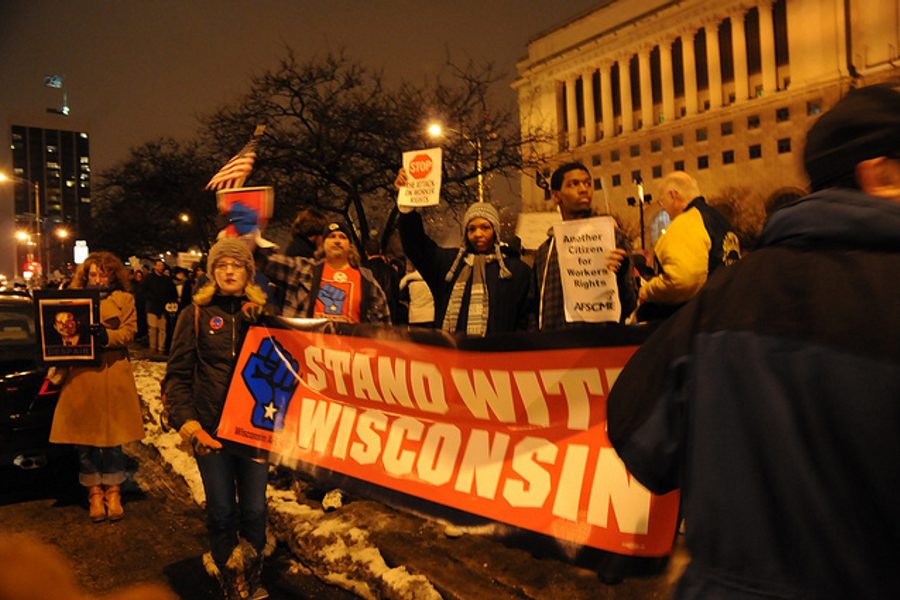
“Fleebagers.” The Fab 14.” “Dereliction of duty.” “Heroes.”
These are just some of the clashing bits of scorn and praise Wisconsin State Senator Jim Holperin’s campaign received in last summer’s recall election. The comments were almost always in reference to the maneuver by the fourteen Wisconsin State Senate Democrats that went to Illinois last February to slow the movement of Governor Scott Walker’s legislation stripping most public employees of their collective bargaining rights. While the strategy proved unsuccessful, the move helped instigate a year and a half of resistance.
Fast-forward to June 5, thirteen primary recall elections and fourteen general recall elections later, the recall bonanza may finally come to an end.
If you only follow national news, the number of elections listed above might confuse you. After significant national coverage of the nine state senate general recall elections last summer, specifically over-hyping the opportunity for Democrats to flip the state senate (it didn’t happen), many national news outlets have since abandoned covering the remaining four state senate recall races.
While the focus in on the Governor’s race, the overlooked results of the recalls could reflect a sentiment about how voters nationwide will respond to the radical policies being pushed at the state level by the wave of Republicans elected in 2010. Once again, Wisconsin Democrats have the chance once again to flip the senate. This time, it might actually be possible.
Here is a brief summary of the four state senate recall elections also occurring on June 5.
Senate District 13:
The Seat: Currently held by Republican Senate Majority Leader Scott Fitzgerald, he was first elected to the Senate in 1994 after defeating 14-year Republican incumbent Barbara Lorman. Now Fitzgerald is being challenged by Democrat Lori Compas who notably led a grassroots recall effort against him.
The District: A Republican stronghold, the district is about 20 miles east of Madison. It is predominately rural, spotted with small towns. Since elected in 1994, Fitzgerald has effortlessly retained the seat.
The Results: Lori Compas is putting up a strong fight against Fitzgerald without nearly the amount of party support and attention as the other races have received. Arguably, this is the first time Fitzgerald has actually had to campaign to defend his seat. Despite Compas’s efforts, it appears highly unlikely that she will win. While dated, an April poll by Public Policy Polling on behalf of Daily Kos had Fitzgerald leading by 54-40.
Senate District 21:
The Seat: Republican Senator Van Wanggaard was elected to the senate in 2010, beating first term Democratic Senator John Lehman. In a rematch, Wanggaard and Lehman will square off again in the recall election. A historically swing district, this is the only place in America where a state senate recall election has been held twice.
The District: Located in southeastern Wisconsin, the district is contained entirely in Racine County. The largest population is in Racine, which typically leans Democratic, while the rural part of the district, west of Interstate 94, leans Republican.
The Result: This is the most contested of the four races and will likely be the tightest. Polling results have consistently shown Lehman and Wanggaard are neck and neck. Democrats are hedging their bets on winning this seat to help win back the majority.
(Full disclosure: I managed the John Lehman for Senate campaign in 2010.)
Senate District 23
The Seat: Currently held by Republican Terry Moulton, he previously served 2 terms in the Wisconsin State Assembly (2004−2008) and was elected to the Senate in 2010. He will face off against former Democratic State Representative Kristin Dexter, who defeated Moulton in 2008 for the assembly seat and lost her seat in 2010.
The District: Covering part of western Wisconsin, the district has a Democratic advantage. The district contains a public University that is typically part of a large Democratic turnout effort. However, with the timing of the recall elections, Democrats are looking elsewhere to offset the loss.
The Result: Similar to the race in Senate District 21, the race between Moulton and Dexter will be close. Polls have provided sporadic results, some giving Moulton large leads while others indicate a virtual dead heat. Like the other races, it’s unclear what the impact of the increased TV, radio and internet ad buys in the last two weeks will have on the elections final results.
Senate District 29
The Seat: Vacant. In a weird turn of events, former Republican State Senator Pam Galloway resigned from her seat in March. Galloway won the seat in 2010, defeating Democratic incumbent Majority Leader Russ Decker. Current Democratic State Representative Donna Seidel had announced her intentions to run for the seat before Galloway resigned. Seidel will now face Republican State Representative Jerry Petrowski in the election.
The District: Covering a large swath of rural central and north-central Wisconsin, most of the district’s populace is in the Wausau area. As a 22-year resident of the district, I commonly heard stereotypes about the districts gun touting, deer hunting and conservative constituents. Despite the stereotypes, the district has a Democratic lean as is evident by Democratic Senator Russ Decker holding the seat from 1990-2010.
The Results: As current State Representatives, both Seidel and Petrowski are well known and well liked throughout the district. However, poll results have been more favorable for Petrowski. The possible saving grace — if polls are to be believed — is Seidel’s popularity with women. With high female turnout, Seidel’s resonating message might be enough to win.
On June 5, there will be plenty to watch in Wisconsin. Let’s not forget about the maneuver State Senate Democrats played last February while Republicans broke all the rules shoving through a Governor Walker’s Budget Repair Bill, which helped to launch Wisconsin into recall frenzy.



